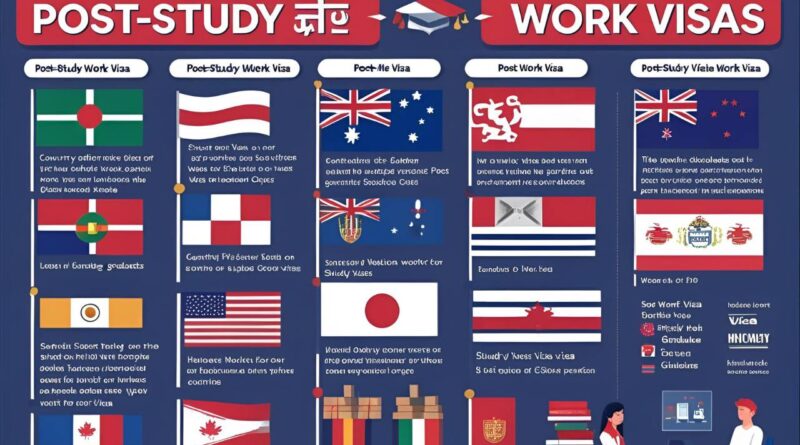Post-Study Work Visas: Which Countries Offer the Best Options
Introduction
So, you’ve finally graduated—congrats! Now what? For many international students, the dream doesn’t end with a degree. It’s just the beginning. A post-study work visa is your ticket to gain practical experience, pay back student loans, and even secure permanent residency. But where should you go? Let’s explore which countries offer the most generous and student-friendly post-study work options.
Understanding Post-Study Work Visas
What Are They Exactly?
A post-study work visa allows international graduates to stay back in the country where they studied and work for a specific period. It bridges the gap between student life and professional employment.
Who’s Eligible?
Typically, eligibility depends on:
- Completing a degree at a recognized institution
- Holding a valid student visa at the time of application
- Applying within a specified period after graduation
Duration and Intent

Benefits of Post-Study Work Visas
Why bother? Because they offer:
- Real-world experience: Put your skills to work right away.
- Residency pathways: Many post-study visas lead to permanent residency.
- Financial payoff: Offset tuition costs and student loans.
Top Countries Offering the Best Post-Study Work Visas
Canada: The Friendly Giant
Visa Type: Post-Graduation Work Permit (PGWP)
Duration: Up to 3 years
Highlights:
- No job offer required
- Pathway to Canadian Permanent Residency through Express Entry
- Welcoming multicultural society
Australia: The Land Down Under
Visa Type: Temporary Graduate Visa (Subclass 485)
Streams:
- Graduate Work (for vocational training)
- Post-Study Work (for university grads)
Duration: Up to 4 years depending on qualification and location
Bonus: Extra benefits for studying in regional areas
United Kingdom: Old School, New Rules
Visa Type: Graduate Route
Duration: 2 years (3 for PhD grads)
Perks:
- No sponsorship required
- Open to all fields
- Leads to Skilled Worker visa
Germany: Engineering Your Future
Visa Type: 18-Month Job-Seeking Visa
What’s Great:
- Low tuition fees already a big plus
- High demand in STEM fields
- Can switch to EU Blue Card once employed
New Zealand: The Scenic Career Stop
Visa Type: Post-Study Work Visa
Duration: Up to 3 years
Why NZ:
- Friendly immigration policies
- Opportunities to transition into Work to Residence Visa
- Skills shortages in health, engineering, and IT
Ireland: The Emerald Tech Hub
Visa Type: Third Level Graduate Scheme
Duration: 1 year (Bachelor’s) or 2 years (Master’s)
Why Go:
- Booming tech and pharmaceutical sectors
- Easy entry into job market
- English-speaking environment
United States: The Big Dream
Visa Type: OPT (Optional Practical Training)
Extension: 24 months for STEM fields
Challenges:
- H-1B visa lottery is competitive
Perks: - World-class employers
- High earning potential
Netherlands: The Dutch Launchpad
Visa Type: Orientation Year (Zoekjaar)
Duration: 12 months
Advantages:
- Access to the Highly Skilled Migrant scheme
- English-taught degrees widely available
- Progressive society with high quality of life
France: The Cultural Capital
Visa Type: APS (Autorisation Provisoire de Séjour)
Duration: 1 year
Highlights:
- Access to French labor market
- Potential to move into Talent Passport for long-term stay
- Rich cultural and business landscape
Comparing Visa Benefits
| Country | Duration | PR Pathway | Sponsorship Required | Language |
|---|---|---|---|---|
| Canada | Up to 3 years | Yes | No | English/French |
| Australia | Up to 4 years | Yes | No (initially) | English |
| UK | 2–3 years | Yes | No (initially) | English |
| Germany | 18 months | Yes | No | German/English |
| New Zealand | Up to 3 years | Yes | No | English |
| Ireland | 1–2 years | Yes | No | English |
| USA | 1–3 years (OPT) | Yes (H-1B) | Yes (after OPT) | English |
| Netherlands | 12 months | Yes | No (initially) | English/Dutch |
| France | 1 year | Yes | No (initially) | French/English |
Common Challenges Students Face
- Visa processing delays: Sometimes it’s a waiting game.
- Job market competitiveness: Especially in saturated cities.
- Legal confusion: Rules vary by state, employer, and visa class.
Tips to Maximize Post-Study Opportunities
- Start early: Plan your career goals before you even graduate.
- Use campus resources: Career centers and alumni networks can be goldmines.
- Target shortage sectors: Healthcare, IT, engineering, and education are in demand.
Future Trends in Post-Study Work Visas
- Remote-friendly policies: Digital nomad visas are on the rise.
- Tech-driven migration: STEM graduates are more in demand than ever.
- Policy shifts: Countries may adjust visa durations and quotas based on labor needs.
Conclusion
Choosing where to study is just half the battle—the real adventure starts after graduation. A strong post-study visa option can turn your degree into a long-term career. Whether it’s Canada’s PR path, Australia’s flexibility, or Germany’s engineering demand, the choice depends on your goals, field, and lifestyle preferences. So, do your homework, dream big, and start planning that next chapter today.
FAQs
1. What is the longest post-study visa available?
Australia offers up to 4 years for eligible degrees, especially in regional areas.
2. Which country has the easiest PR process after study?
Canada is widely known for its clear and student-friendly permanent residency pathways.
3. Can I work part-time while on a post-study visa?
Yes, most countries allow full-time work under post-study visas, but always check specific country laws.
4. How much does it cost to apply for a post-study visa?
It varies: Canada ~CAD 255, UK ~GBP 822, Australia ~AUD 1,895, etc.
5. Can my family accompany me on a post-study visa?
In many cases, yes—Australia, Canada, and the UK allow dependents to join or apply separately.



